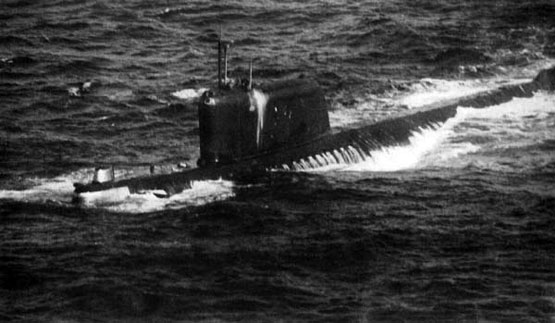Agat was utilized in the motion picture K-19: The Widowmaker.
Storyline: The story of USSR’s first nuclear ballistic submarine, which suffered a malfunction in its nuclear reactor on its maiden voyage in the North Atlantic in 1961. The submarine’s crew, led by the unyielding Captain Alexi Vostrikov, races against time to prevent a Chernobyl-like nuclear disaster which threatens not only the lives of his crew, but has the potential to ignite a world war between the super powers.
An Agat stopwatch is intended for measuring time in minutes, seconds and fractions of a second. Handy when conducting sports competitions as well as in scientific research work and motion-time study. Or shooting a Hollywood blockbuster!
Clockwork: caliber 42 mm, 16 jewels, spring actuator, lever escapement, balance-spiral oscillator system with 0,4 s oscillation period.
Power reserve: Single complete winding operation time: 18 h, minimum.
Hands: controlled by a special summing-effect device provided in stop-watch clockwork. Started and stopped by depressions of winding crown and reset to zero by depression to button.
Dial: 60-second stop-watch dial, with 0,2-second division value. 60-min counter, with 1-min division value. Chrome-plated metal case.
Case: Metal, chromium-plated case.
Movie Background: K-19: The Widowmaker: ENGLISH
Soviet submarine K-19 was one of the first two Soviet submarines of the first generation nuclear submarine equipped with nuclear ballistic missiles.
On 4 July 1961, under the command of Captain First Rank Nikolai Vladimirovich Zateyev, K-19 was conducting exercises in the North Atlantic close to Southern Greenland when she developed a major leak in her reactor coolant system, causing the water pressure in the aft reactor to drop to zero and causing failure of the coolant pumps. A separate accident had disabled her long-range radio system, so she could not contact Moscow. The reactor temperature rose uncontrollably, reaching 800 °C — almost the melting point of the fuel rods — and the chain reactions continued despite the control rods being inserted via a SCRAM mechanism. The reactor continued to heat up as coolant is still required during shutdown until the reactions decrease. Despite Zateyev’s and others’ earlier requests, no backup cooling system had been installed.
As a cooling back-up system had not been installed, Zateyev made a drastic decision: a team of seven engineering officers and crew worked for extended periods in high-radiation areas to implement a new coolant system by cutting off an air vent valve and welding a water-supplying pipe into it. Since the ship carried chemical suits, instead of radiation suits, they were certain to be lethally contaminated,[citation needed] but the repair team was unaware of the degree of risk, believing the suits they wore would protect them from contamination. The released radioactive steam, containing fission products, was drawn into the ventilation system and spread to other sections of the ship. The cooling water pumped from the reactor section worked well.
The incident contaminated the crew, parts of the ship, and some of the ballistic missiles carried on board; the entire crew received substantial doses of radiation, and all seven men in the repair crew died of radiation exposure within a week, and twenty more within the next few years. The captain decided to head south to meet diesel submarines expected to be there, instead of continuing on the mission’s planned route. Worries about a potential crew mutiny prompted Zateyev to have all small arms thrown overboard except for five pistols distributed to his most trusted officers. A diesel submarine, S-270, picked up K-19’s low-power distress transmissions and rendezvoused with her.
Film Hintergrund: K-19: Showdown in der Tiefe: GERMAN
K-19 war ein sowjetisches Atom-U-Boot der Hotel-Klasse, das mit 2 Kernreaktoren betrieben wurde. Es hatte als erstes nuklear angetriebenes U-Boot der sowjetischen Marine ballistische Atomwaffen an Bord. Die drei Raketen hatten eine Reichweite von 650 km und eine Sprengkraft von je 1,4 Megatonnen TNT-Äquivalent. Der Kapitän war Nikolai Satejew (19261999).
Während des ersten Einsatzes kam es am 4. Juli 1961 an Bord zu einem Störfall an einem Reaktor, als ein Leck im Primärkühlkreis zum Ausfall der Kühlung führte. Konstruktionsbedingt setzte sich die Kettenreaktion fort und es drohte eine Kernschmelze. Es wurde darauf provisorisch eine Notkühlung angebracht, bei deren Montage die Wartungstechniker hohen Dosen ionisierender Strahlung ausgesetzt waren. Sieben Techniker starben innerhalb einer Woche an der Strahlenkrankheit.





Leave a Reply
Want to join the discussion?Feel free to contribute!